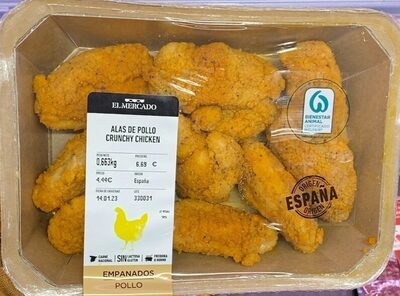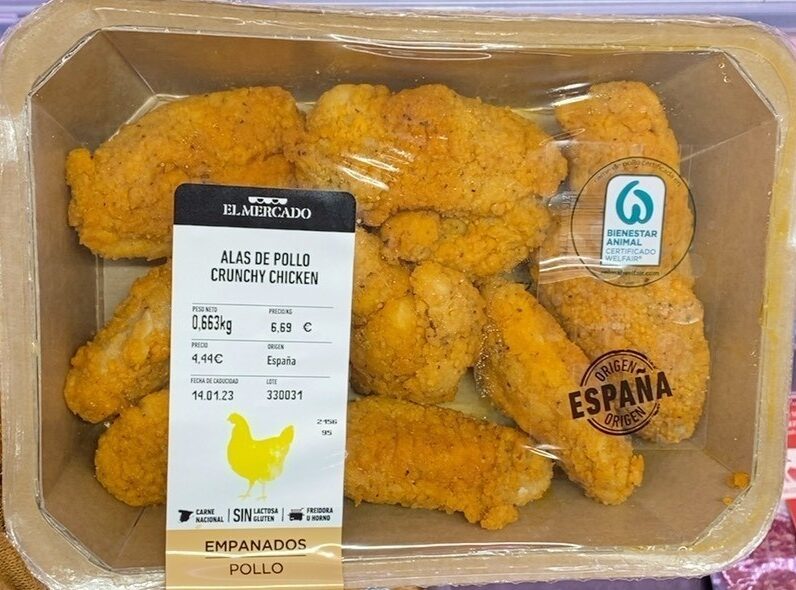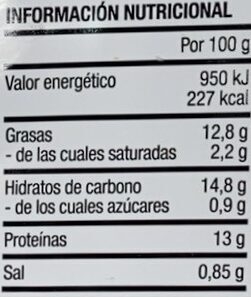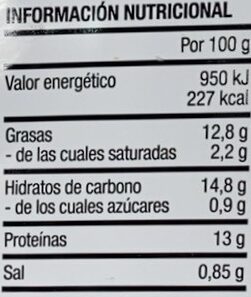Help us make food transparency the norm!
As a non-profit organization, we depend on your donations to continue informing consumers around the world about what they eat.
The food revolution starts with you!
Alas Crunchy chicken - el mercado de aldi
Alas Crunchy chicken - el mercado de aldi
This product page is not complete. You can help to complete it by editing it and adding more data from the photos we have, or by taking more photos using the app for Android or iPhone/iPad. Thank you!
×
Barra-kodea: 2161860004442 (EAN / EAN-13)
Markak: el mercado de aldi
Kategoriak: en:Meats and their products, en:Meats, en:Chicken and its products, en:Poultries, Oilo, en:Chicken wings
Etiketak, ziurtagiriak, sariak:
en:No gluten, en:Animal welfare, en:No lactose, es:bienestar-animal, es:Recicla-amarillo, es:Recicla-azul

Origin of ingredients: Espainia
Manufacturing or processing places: España
Traceability code: ES 10.024562/V CE
Dendak: Aldi
Saltzen diren herrialdeak: Espainia
Matching with your preferences
Health
Osagaiak
-
50 ingredients
Gaztelania: ALAS DE POLLO MARINADAS (82%): ALAS DE POLLO (78%), AGUA, AROMAS, CONSERVADORES (E-325, E-262), SAL, ANTIOXIDANTES (E-331, E-301), FIBRAS VEGETALES, DEXTROSA, HARINA DE ARROZ Y MAIZ, DEXTRINA, JARABE DE GLUCOSA, FIBRA, REGULADOR DE ACIDEZ (E-500), ESPESANTE (E-412), VEGETALES DESHIDRATADOS (CEBOLLA Y AJO), ESPECIAS, AZÚCAR, AROMAS. COBERTURA (18%): REBOZADO (HARINA DE ARROZ, ALMIDÓN, ESPECIAS, VEGETALES DESHIDRATADOS (PIMENTÓN), ACEITE DE GIRASOL Y AROMAS), ENCOLANTE (ALMIDÓN, PROTEINA VEGETAL, SAL, FIBRA VEGETAL, ESTABILIZANTE (E-451), CONSERVADOR (E-200), COLORANTE (E-150a) Y ESPESANTE (E-412)).
Food processing
-
Ultra processed foods
Elements that indicate the product is in the 4 - Ultra prozesatutako elikagaiak eta edariak group:
- Gehigarria: E1400 - Destrina
- Gehigarria: E150a
- Gehigarria: E325
- Gehigarria: E412
- Gehigarria: E451
- Osagaia: Colour
- Osagaia: Dextrose
- Osagaia: Flavouring
- Osagaia: Glukosa
- Osagaia: Almibar
- Osagaia: Thickener
Food products are classified into 4 groups according to their degree of processing:
- Prozesatu gabeko edo ahalik eta gutxien prozesatutako elikagaiak
- Sukaldaritzako osagaiak prozesatu
- Prozesatutako jakiak
- Ultra processed foods
The determination of the group is based on the category of the product and on the ingredients it contains.
Gehigarriak
-
E1400 - Destrina
Dextrin: Dextrins are a group of low-molecular-weight carbohydrates produced by the hydrolysis of starch or glycogen. Dextrins are mixtures of polymers of D-glucose units linked by α--1→4- or α--1→6- glycosidic bonds. Dextrins can be produced from starch using enzymes like amylases, as during digestion in the human body and during malting and mashing, or by applying dry heat under acidic conditions -pyrolysis or roasting-. The latter process is used industrially, and also occurs on the surface of bread during the baking process, contributing to flavor, color and crispness. Dextrins produced by heat are also known as pyrodextrins. The starch hydrolyses during roasting under acidic conditions, and short-chained starch parts partially rebranch with α--1‚6- bonds to the degraded starch molecule. See also Maillard Reaction. Dextrins are white, yellow, or brown powders that are partially or fully water-soluble, yielding optically active solutions of low viscosity. Most of them can be detected with iodine solution, giving a red coloration; one distinguishes erythrodextrin -dextrin that colours red- and achrodextrin -giving no colour-. White and yellow dextrins from starch roasted with little or no acid are called British gum.Source: Wikipedia (Ingeles)
-
E200
Sorbic acid: Sorbic acid, or 2‚4-hexadienoic acid, is a natural organic compound used as a food preservative. It has the chemical formula CH3-CH-4CO2H. It is a colourless solid that is slightly soluble in water and sublimes readily. It was first isolated from the unripe berries of the Sorbus aucuparia -rowan tree-, hence its name.Source: Wikipedia (Ingeles)
-
E262
Sodium acetate: Sodium acetate, CH3COONa, also abbreviated NaOAc, is the sodium salt of acetic acid. This colorless deliquescent salt has a wide range of uses.Source: Wikipedia (Ingeles)
-
E301
Sodium ascorbate: Sodium ascorbate is one of a number of mineral salts of ascorbic acid -vitamin C-. The molecular formula of this chemical compound is C6H7NaO6. As the sodium salt of ascorbic acid, it is known as a mineral ascorbate. It has not been demonstrated to be more bioavailable than any other form of vitamin C supplement.Sodium ascorbate normally provides 131 mg of sodium per 1‚000 mg of ascorbic acid -1‚000 mg of sodium ascorbate contains 889 mg of ascorbic acid and 111 mg of sodium-. As a food additive, it has the E number E301 and is used as an antioxidant and an acidity regulator. It is approved for use as a food additive in the EU, USA, and Australia and New Zealand.In in vitro studies, sodium ascorbate has been found to produce cytotoxic effects in various malignant cell lines, which include melanoma cells that are particularly susceptible.Source: Wikipedia (Ingeles)
-
E325
Sodium lactate: Sodium lactate is the sodium salt of lactic acid, and has a mild saline taste. It is produced by fermentation of a sugar source, such as corn or beets, and then, by neutralizing the resulting lactic acid to create a compound having the formula NaC3H5O3.Source: Wikipedia (Ingeles)
-
E331
Sodium citrate: Sodium citrate may refer to any of the sodium salts of citrate -though most commonly the third-: Monosodium citrate Disodium citrate Trisodium citrateThe three forms of the salt are collectively known by the E number E331. Sodium citrates are used as acidity regulators in food and drinks, and also as emulsifiers for oils. They enable cheeses to melt without becoming greasy.Source: Wikipedia (Ingeles)
-
E412
Guar gum: Guar gum, also called guaran, is a galactomannan polysaccharide extracted from guar beans that has thickening and stabilizing properties useful in the food, feed and industrial applications. The guar seeds are mechanically dehusked, hydrated, milled and screened according to application. It is typically produced as a free-flowing, off-white powder.Source: Wikipedia (Ingeles)
-
E451
Sodium triphosphate: Sodium triphosphate -STP-, also sodium tripolyphosphate -STPP-, or tripolyphosphate -TPP-,- is an inorganic compound with formula Na5P3O10. It is the sodium salt of the polyphosphate penta-anion, which is the conjugate base of triphosphoric acid. It is produced on a large scale as a component of many domestic and industrial products, especially detergents. Environmental problems associated with eutrophication are attributed to its widespread use.Source: Wikipedia (Ingeles)
-
E500
Sodium carbonate: Sodium carbonate, Na2CO3, -also known as washing soda, soda ash and soda crystals, and in the monohydrate form as crystal carbonate- is the water-soluble sodium salt of carbonic acid. It most commonly occurs as a crystalline decahydrate, which readily effloresces to form a white powder, the monohydrate. Pure sodium carbonate is a white, odorless powder that is hygroscopic -absorbs moisture from the air-. It has a strongly alkaline taste, and forms a moderately basic solution in water. Sodium carbonate is well known domestically for its everyday use as a water softener. Historically it was extracted from the ashes of plants growing in sodium-rich soils, such as vegetation from the Middle East, kelp from Scotland and seaweed from Spain. Because the ashes of these sodium-rich plants were noticeably different from ashes of timber -used to create potash-, they became known as "soda ash". It is synthetically produced in large quantities from salt -sodium chloride- and limestone by a method known as the Solvay process. The manufacture of glass is one of the most important uses of sodium carbonate. Sodium carbonate acts as a flux for silica, lowering the melting point of the mixture to something achievable without special materials. This "soda glass" is mildly water-soluble, so some calcium carbonate is added to the melt mixture to make the glass produced insoluble. This type of glass is known as soda lime glass: "soda" for the sodium carbonate and "lime" for the calcium carbonate. Soda lime glass has been the most common form of glass for centuries. Sodium carbonate is also used as a relatively strong base in various settings. For example, it is used as a pH regulator to maintain stable alkaline conditions necessary for the action of the majority of photographic film developing agents. It acts as an alkali because when dissolved in water, it dissociates into the weak acid: carbonic acid and the strong alkali: sodium hydroxide. This gives sodium carbonate in solution the ability to attack metals such as aluminium with the release of hydrogen gas.It is a common additive in swimming pools used to raise the pH which can be lowered by chlorine tablets and other additives which contain acids. In cooking, it is sometimes used in place of sodium hydroxide for lyeing, especially with German pretzels and lye rolls. These dishes are treated with a solution of an alkaline substance to change the pH of the surface of the food and improve browning. In taxidermy, sodium carbonate added to boiling water will remove flesh from the bones of animal carcasses for trophy mounting or educational display. In chemistry, it is often used as an electrolyte. Electrolytes are usually salt-based, and sodium carbonate acts as a very good conductor in the process of electrolysis. In addition, unlike chloride ions, which form chlorine gas, carbonate ions are not corrosive to the anodes. It is also used as a primary standard for acid-base titrations because it is solid and air-stable, making it easy to weigh accurately.Source: Wikipedia (Ingeles)
Ingredients analysis
-
en:Palm oil free
No ingredients containing palm oil detected
Unrecognized ingredients: es:cobertura, es:rebozadoSome ingredients could not be recognized.
We need your help!
You can help us recognize more ingredients and better analyze the list of ingredients for this product and others:
- Edit this product page to correct spelling mistakes in the ingredients list, and/or to remove ingredients in other languages and sentences that are not related to the ingredients.
- Add new entries, synonyms or translations to our multilingual lists of ingredients, ingredient processing methods, and labels.
If you would like to help, join the #ingredients channel on our Slack discussion space and/or learn about ingredients analysis on our wiki. Thank you!
-
en:Non-vegan
Non-vegan ingredients: en:Chicken wing, en:Chicken wingSome ingredients could not be recognized.
We need your help!
You can help us recognize more ingredients and better analyze the list of ingredients for this product and others:
- Edit this product page to correct spelling mistakes in the ingredients list, and/or to remove ingredients in other languages and sentences that are not related to the ingredients.
- Add new entries, synonyms or translations to our multilingual lists of ingredients, ingredient processing methods, and labels.
If you would like to help, join the #ingredients channel on our Slack discussion space and/or learn about ingredients analysis on our wiki. Thank you!
-
en:Non-vegetarian
Non-vegetarian ingredients: en:Chicken wing, en:Chicken wingSome ingredients could not be recognized.
We need your help!
You can help us recognize more ingredients and better analyze the list of ingredients for this product and others:
- Edit this product page to correct spelling mistakes in the ingredients list, and/or to remove ingredients in other languages and sentences that are not related to the ingredients.
- Add new entries, synonyms or translations to our multilingual lists of ingredients, ingredient processing methods, and labels.
If you would like to help, join the #ingredients channel on our Slack discussion space and/or learn about ingredients analysis on our wiki. Thank you!
-
Details of the analysis of the ingredients
We need your help!
Some ingredients could not be recognized.
We need your help!
You can help us recognize more ingredients and better analyze the list of ingredients for this product and others:
- Edit this product page to correct spelling mistakes in the ingredients list, and/or to remove ingredients in other languages and sentences that are not related to the ingredients.
- Add new entries, synonyms or translations to our multilingual lists of ingredients, ingredient processing methods, and labels.
If you would like to help, join the #ingredients channel on our Slack discussion space and/or learn about ingredients analysis on our wiki. Thank you!
es: ALAS DE POLLO 82% (ALAS DE POLLO 78%), AGUA, AROMAS, CONSERVADORES (e325, e262), SAL, ANTIOXIDANTES (e331, e301), FIBRAS VEGETALES, DEXTROSA, HARINA DE ARROZ, MAIZ, DEXTRINA, JARABE DE GLUCOSA, FIBRA, REGULADOR DE ACIDEZ (e500), ESPESANTE (e412), VEGETALES (CEBOLLA, AJO), ESPECIAS, AZÚCAR, AROMAS, COBERTURA 18% (REBOZADO, HARINA DE ARROZ), ALMIDÓN, ESPECIAS, VEGETALES (PIMENTÓN), ACEITE DE GIRASOL, AROMAS, ENCOLANTE (ALMIDÓN, PROTEINA VEGETAL, SAL, FIBRA VEGETAL, ESTABILIZANTE (e451), CONSERVADOR (e200), COLORANTE (e150a), ESPESANTE (e412))- ALAS DE POLLO -> en:chicken-wing - vegan: no - vegetarian: no - ciqual_food_code: 36023 - percent: 82
- ALAS DE POLLO -> en:chicken-wing - vegan: no - vegetarian: no - ciqual_food_code: 36023 - percent: 78
- AGUA -> en:water - vegan: yes - vegetarian: yes - ciqual_food_code: 18066
- AROMAS -> en:flavouring - vegan: maybe - vegetarian: maybe
- CONSERVADORES -> en:preservative
- e325 -> en:e325 - vegan: yes - vegetarian: yes
- e262 -> en:e262 - vegan: yes - vegetarian: yes
- SAL -> en:salt - vegan: yes - vegetarian: yes - ciqual_food_code: 11058
- ANTIOXIDANTES -> en:antioxidant
- e331 -> en:e331 - vegan: yes - vegetarian: yes
- e301 -> en:e301 - vegan: yes - vegetarian: yes
- FIBRAS VEGETALES -> en:fiber
- DEXTROSA -> en:dextrose - vegan: yes - vegetarian: yes - ciqual_proxy_food_code: 31016
- HARINA DE ARROZ -> en:rice-flour - vegan: yes - vegetarian: yes - ciqual_food_code: 9520
- MAIZ -> en:corn - vegan: yes - vegetarian: yes - ciqual_food_code: 9200
- DEXTRINA -> en:e1400 - vegan: yes - vegetarian: yes
- JARABE DE GLUCOSA -> en:glucose-syrup - vegan: yes - vegetarian: yes - ciqual_proxy_food_code: 31016
- FIBRA -> en:fiber
- REGULADOR DE ACIDEZ -> en:acidity-regulator
- e500 -> en:e500 - vegan: yes - vegetarian: yes
- ESPESANTE -> en:thickener
- e412 -> en:e412 - vegan: yes - vegetarian: yes
- VEGETALES -> en:vegetable - vegan: yes - vegetarian: yes
- CEBOLLA -> en:onion - vegan: yes - vegetarian: yes - ciqual_food_code: 20034
- AJO -> en:garlic - vegan: yes - vegetarian: yes - ciqual_food_code: 11000
- ESPECIAS -> en:spice - vegan: yes - vegetarian: yes
- AZÚCAR -> en:sugar - vegan: yes - vegetarian: yes - ciqual_proxy_food_code: 31016
- AROMAS -> en:flavouring - vegan: maybe - vegetarian: maybe
- COBERTURA -> es:cobertura - percent: 18
- REBOZADO -> es:rebozado
- HARINA DE ARROZ -> en:rice-flour - vegan: yes - vegetarian: yes - ciqual_food_code: 9520
- ALMIDÓN -> en:starch - vegan: yes - vegetarian: yes - ciqual_proxy_food_code: 9510
- ESPECIAS -> en:spice - vegan: yes - vegetarian: yes
- VEGETALES -> en:vegetable - vegan: yes - vegetarian: yes
- PIMENTÓN -> en:paprika - vegan: yes - vegetarian: yes - ciqual_food_code: 11049
- ACEITE DE GIRASOL -> en:sunflower-oil - vegan: yes - vegetarian: yes - from_palm_oil: no - ciqual_food_code: 17440
- AROMAS -> en:flavouring - vegan: maybe - vegetarian: maybe
- ENCOLANTE -> en:glue
- ALMIDÓN -> en:starch - vegan: yes - vegetarian: yes - ciqual_proxy_food_code: 9510
- PROTEINA VEGETAL -> en:plant-protein - vegan: yes - vegetarian: yes
- SAL -> en:salt - vegan: yes - vegetarian: yes - ciqual_food_code: 11058
- FIBRA VEGETAL -> en:vegetable-fiber - vegan: yes - vegetarian: yes
- ESTABILIZANTE -> en:stabiliser
- e451 -> en:e451 - vegan: yes - vegetarian: yes
- CONSERVADOR -> en:preservative
- e200 -> en:e200 - vegan: yes - vegetarian: yes
- COLORANTE -> en:colour
- e150a -> en:e150a - vegan: yes - vegetarian: yes
- ESPESANTE -> en:thickener
- e412 -> en:e412 - vegan: yes - vegetarian: yes
Elikadura
-
Good nutritional quality
⚠ ️Abisua: zuntz kopurua ez dago zehaztuta, ezin izan dute kontuan izan kalifikaziorako izan dezaketen ekarpen positiboa.⚠ ️Warning: the amount of fruits, vegetables and nuts is not specified on the label, it was estimated from the list of ingredients: 0This product is not considered a beverage for the calculation of the Nutri-Score.
Positive points: 5
- Proteinak: 5 / 5 (balioa: 13, rounded value: 13)
- Fiber: 0 / 5 (balioa: 0, rounded value: 0)
- Fruits, vegetables, nuts, and colza/walnut/olive oils: 0 / 5 (balioa: 0.00054931640625, rounded value: 0)
Negative points: 7
- Energia: 2 / 10 (balioa: 950, rounded value: 950)
- Azukreak: 0 / 10 (balioa: 0.9, rounded value: 0.9)
- Gantz saturatua: 2 / 10 (balioa: 2.2, rounded value: 2.2)
- Sodioa: 3 / 10 (balioa: 340, rounded value: 340)
The points for proteins are counted because the negative points are less than 11.
Nutritional score: (7 - 5)
Nutri-Score:
-
Nutrient levels
-
Koipe in moderate quantity (12.8%)
What you need to know- A high consumption of fat, especially saturated fats, can raise cholesterol, which increases the risk of heart diseases.
Recommendation: Limit the consumption of fat and saturated fat- Choose products with lower fat and saturated fat content.
-
Gantz-azido ase in moderate quantity (2.2%)
What you need to know- A high consumption of fat, especially saturated fats, can raise cholesterol, which increases the risk of heart diseases.
Recommendation: Limit the consumption of fat and saturated fat- Choose products with lower fat and saturated fat content.
-
Azukre in low quantity (0.9%)
What you need to know- A high consumption of sugar can cause weight gain and tooth decay. It also augments the risk of type 2 diabetes and cardio-vascular diseases.
Recommendation: Limit the consumption of sugar and sugary drinks- Sugary drinks (such as sodas, fruit beverages, and fruit juices and nectars) should be limited as much as possible (no more than 1 glass a day).
- Choose products with lower sugar content and reduce the consumption of products with added sugars.
-
Gatz arrunt in moderate quantity (0.85%)
What you need to know- A high consumption of salt (or sodium) can cause raised blood pressure, which can increase the risk of heart disease and stroke.
- Many people who have high blood pressure do not know it, as there are often no symptoms.
- Most people consume too much salt (on average 9 to 12 grams per day), around twice the recommended maximum level of intake.
Recommendation: Limit the consumption of salt and salted food- Reduce the quantity of salt used when cooking, and don't salt again at the table.
- Limit the consumption of salty snacks and choose products with lower salt content.
-
-
Nutrition facts
Nutrition facts As sold
for 100 g / 100 mlCompared to: en:Chicken wings Energia 950 kj
(227 kcal)+% 5 Koipe 12,8 g -% 15 Gantz-azido ase 2,2 g -% 39 Carbohydrates 14,8 g +% 454 Azukre 0,9 g +% 125 Fiber ? Proteina 13 g -% 25 Gatz arrunt 0,85 g -% 23 Fruits‚ vegetables‚ nuts and rapeseed‚ walnut and olive oils (estimate from ingredients list analysis) 0,001 %
Ingurumena
-
Eco-Score C - Moderate environmental impact
The Eco-Score is an experimental score that summarizes the environmental impacts of food products.→ The Eco-Score was initially developped for France and it is being extended to other European countries. The Eco-Score formula is subject to change as it is regularly improved to make it more precise and better suited to each country.Life cycle analysis
-
Average impact of products of the same category: C (Score: 41/100)
Kategoria: Chicken, meat and skin, raw
Kategoria: Chicken, meat and skin, raw
- PEF environmental score: 0.71 (the lower the score, the lower the impact)
- including impact on climate change: 5.52 kg CO2 eq/kg of product
Stage Impact Agriculture
82.8 %Processing
10.5 %Ontziratzea
2.5 %Transportation
2.6 %Distribution
1.3 %Consumption
0.3 %
Bonuses and maluses
-
Origins of ingredients with a low impact
Bonus: +18
Environmental policy: +3
Transportation: +15
Origin of the product and/or its ingredients % of ingredients Impact Espainia 100 %Baxua
-
Missing packaging information for this product
Malus: -15
⚠ ️ The information about the packaging of this product is not filled in.⚠ ️ For a more precise calculation of the Eco-Score, you can modify the product page and add them.
If you are the manufacturer of this product, you can send us the information with our free platform for producers.
Eco-Score for this product
-
Impact for this product: C (Score: 44/100)
Produktua: Alas Crunchy chicken - el mercado de aldi
Life cycle analysis score: 41
Sum of bonuses and maluses: +3
Final score: 44/100
-
Carbon footprint
-
Equal to driving 2.9 km in a petrol car
552 g CO² per 100g of product
The carbon emission figure comes from ADEME's Agribalyse database, for the category: Chicken, meat and skin, raw (Source: ADEME Agribalyse Database)
Stage Impact Agriculture
75.1 %Processing
14.9 %Ontziratzea
5.0 %Transportation
4.2 %Distribution
0.7 %Consumption
0.1 %
Ontziratzea
-
Missing packaging information for this product
⚠ ️ The information about the packaging of this product is not filled in.Take a photo of the recycling information Take a photo of the recycling information
Transportation
-
Origins of ingredients
Origins of ingredients with a low impact
Origin of the product and/or its ingredients % of ingredients Impact Espainia 100 %Baxua
Report a problem
-
Incomplete or incorrect information?
Category, labels, ingredients, allergens, nutritional information, photos etc.
If the information does not match the information on the packaging, please complete or correct it. Open Food Facts is a collaborative database, and every contribution is useful for all.
Datuen iturria
Product added on by kiliweb
Last edit of product page on by thaialagata.
Produktuaren orria -gatik editatua duhowpi, roboto-app, yuka.sY2b0xO6T85zoF3NwEKvll5OaPbihGz-LzfQqVKLmPCDJZnKU9FT67nxFKs.










